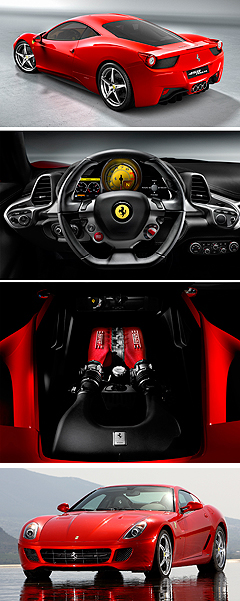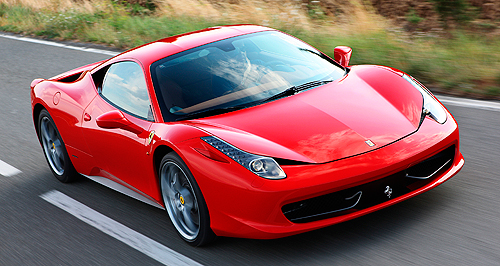Make / Model Search
Future models - Ferrari - 458 - ItaliaFerrari 458 hits OzViva Italia: Deliveries of Ferrari's new 458 Italia are set to start in June. Fever-pitch 458 Italia lands Down Under as Ferrari CEO rules out electric supercar2 Feb 2010 FERRARI will not produce an all-electric supercar, but it will reveal the first fruits of its hybrid development program in the shape of a petrol-electric 599 at the Geneva motor show next month. So says Ferrari CEO Amedeo Felisa, who made his first visit to Australia this week for the official opening of Ateco Automotive’s $32 million headquarters and the luxurious new Ferrari Maserati Sydney dealership on February 3. Mr Felisa also revealed the first example of Ferrari’s new 458 Italia coupe to arrive Down Under ahead of its formal Australian preview in front of 500 guests and potential customers. The first 458 to land here – a left-hand drive model dedicated to global display duties – will head directly to Dubai after its Australian customer debut. Pricing for the 458, which joins the California coupe-convertible and replaces Ferrari’s entry-level 430 coupe, will be announced within four weeks. Despite an expected price tag of about $580,000, more than 100 well-heeled Australian Ferrari enthusiasts have signed up for the all-new super-coupe, pushing the local waiting list for Ferrari’s newest model out beyond 18 months. First Aussie deliveries are expected to take place four weeks ahead of schedule in June.  Left: Ferrari 458 Italia. Bottom: Ferrari 599 GTB Fiorano. Left: Ferrari 458 Italia. Bottom: Ferrari 599 GTB Fiorano.Mr Felisa, who will also be in Australia for only a handful of days after visiting Ferrari and Maserati’s new dealership in Melbourne, confirmed a convertible Spider version of the 458 will be launched globally in 2011. But he said a lightweight, track-focussed Scuderia version of the 458 – which would similarly replace the outgoing 430 Scuderia – was yet to be developed. The 599 hybrid’s debut at Geneva on March 2 was confirmed by Ferrari chairman Luca di Montezemolo at the recent launch of the Prancing Horse brand’s 2010 formula one car. Mr Felisa said the full parallel hybrid drive system, which has been fitted to a Ferrari test mule for 12 months, would reduce fuel consumption and emissions in the 599 by up to 25 per cent. “We will present the new concept of the hybrid at Geneva. It will be based on the 599, but that doesn’t mean it will debut on that model,” he said. “We have a plan to introduce on our cars new technology that will reduce consumption and emissions. “The next step is to apply the technology on Ferrari cars without changing the characteristics they are famous for.” However, the Ferrari chief cautioned Maranello’s first hybrid model, which would carry a weight penalty of 80kg, was at least five years away from production. “The technology is not ready. The suppliers are not ready. Everything is under-developed. There is a lot of work to so. It is not for tomorrow. “We haven’t decided when (it will be introduced). It will be around that period (2015), but not before five years.” Mr Felisa would not be drawn on specifics of the system to be shown at Geneva, but said it could technically be applied to all Ferrari models, including front-engined and rear-engined models and V8 and V12 vehicles. “If we move on the hybrid I think the technology is applicable on all our models,” he said, adding that the same engineers that developed the KERS brake energy regeneration system for Ferrari’s F1 cars would be responsible for applying it to Ferrari’s road cars. He said the first such fuel-saving system would debut on the California in 2011. “If you couple direct-injection with other technology (a fuel consumption and emissions reduction of) up to 15 per cent is possible. “Then there is cylinder deactivation, stop-start, electric motors for certain functions … we will launch the first of these on the California next year.” Asked if Ferrari would introduce its first six-cylinder engine in an effort to improve the efficiency of its cars, Mr Felisa said: “If I had to answer the question a year ago I would have said no, but attitudes are changing and we build cars for customers … In 20 years, who can say?” However, the Ferrari chief said his company would stop short of a full electric drive system in its attempts to reduce fuel consumption. “If you look at global warming, the right solution is not full electric,” he said. “It’s more a marketing solution that a real one. Sound is just as important as design and performance for Ferrari. We will not make engine sounds with speakers.” In other significant Ferrari news, Mr Felisa confirmed that the highly anticipated GTO version of the 599 was “coming” and that the replacement for Ferrari’s Enzo flagship would not be labelled Enzo and would remain a left-hand-drive-only model. Ferrari sales in Australia fell by 36 per cent in 2009 – lower than the supercar segment’s decline of 42 per cent globally last year – from a record high of 163 in 2008, to just 104 vehicles. It is the lowest number of Ferraris sold in Australia since 2006, when Ateco Automotive owner Neville Crichton and his then-new European Automotive Imports company assumed local distribution of the famed Italian brand. Mr Crichton says the number of Ferrari models allocated for Australia has doubled under his stewardship and the lack of new models was partly to blame for last year’s sales slump. “Buyers are starting to come out of the woodwork again, but some can’t be seen a $500,000 car when they’ve just laid-off 500 people,” he said. “But Ferrari’s biggest problem is a lack of new models – the 430 went out of production early last year and the California arrived late. Getting finance was also a big problem last year,” said Mr Crichton, whose EAI importership remains one of the world’s few privately-owned Ferrari distributors. Mr Crichton said that, with the exception of Great Wall and Chery (see separate story), he expected sales across Ateco’s and EAI’s brands – including Ferrari, Maserati, Alfa Romeo, Fiat and Citroen – to remain static in 2010. Mr Felisa went further, predicting the global supercar market, in which sales of its V12 models have declined more than V8s, could remain relatively depressed for up to seven years after the disappearance of 30 per cent of its client base.  Read moreAll future models Alfa Romeo Alfa Romeo Abarth Abarth Alpine Alpine Alpina Alpina Audi Audi Aston Martin Aston Martin BMW BMW Bentley Bentley Chery Chery Brabham Brabham Chrysler Chrysler Chevrolet Chevrolet Cupra Cupra Citroen Citroen DS DS Dodge Dodge Fiat Fiat Ferrari Ferrari Foton Foton Ford Ford Great Wall Great Wall FPV FPV Haval Haval GWM GWM Honda Honda Holden Holden Hummer Hummer HSV HSV Infiniti Infiniti Hyundai Hyundai Jaguar Jaguar Isuzu Isuzu Kia Kia Jeep Jeep Land Rover Land Rover Lamborghini Lamborghini Lexus Lexus LDV LDV Mahindra Mahindra Lotus Lotus Mazda Mazda Maserati Maserati Mercedes-AMG Mercedes-AMG McLaren McLaren MG MG Mercedes-Benz Mercedes-Benz Mitsubishi Mitsubishi Mini Mini Opel Opel Nissan Nissan Peugeot Peugeot Pagani Pagani Proton Proton Porsche Porsche Renault Renault Ram Ram Rover Rover Rolls-Royce Rolls-Royce Skoda Skoda Saab Saab SsangYong SsangYong Smart Smart Suzuki Suzuki Subaru Subaru Toyota Toyota Tesla Tesla Volvo VolvoMotor industry news |
Click to shareFerrari modelsResearch Ferrari All future models Alfa Romeo Alfa Romeo Abarth Abarth Alpine Alpine Alpina Alpina Audi Audi Aston Martin Aston Martin BMW BMW Bentley Bentley Chery Chery Brabham Brabham Chrysler Chrysler Chevrolet Chevrolet Cupra Cupra Citroen Citroen DS DS Dodge Dodge Fiat Fiat Ferrari Ferrari Foton Foton Ford Ford Great Wall Great Wall FPV FPV Haval Haval GWM GWM Honda Honda Holden Holden Hummer Hummer HSV HSV Infiniti Infiniti Hyundai Hyundai Jaguar Jaguar Isuzu Isuzu Kia Kia Jeep Jeep Land Rover Land Rover Lamborghini Lamborghini Lexus Lexus LDV LDV Mahindra Mahindra Lotus Lotus Mazda Mazda Maserati Maserati Mercedes-AMG Mercedes-AMG McLaren McLaren MG MG Mercedes-Benz Mercedes-Benz Mitsubishi Mitsubishi Mini Mini Opel Opel Nissan Nissan Peugeot Peugeot Pagani Pagani Proton Proton Porsche Porsche Renault Renault Ram Ram Rover Rover Rolls-Royce Rolls-Royce Skoda Skoda Saab Saab SsangYong SsangYong Smart Smart Suzuki Suzuki Subaru Subaru Toyota Toyota Tesla Tesla Volvo VolvoMotor industry news |











Facebook Twitter Instagram